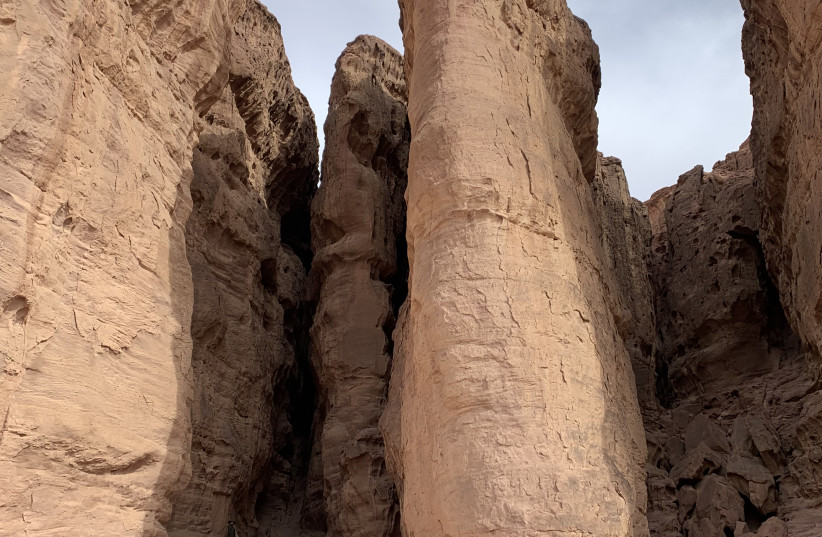Perhaps one of the country’s best-kept secrets is its southern Arava region, running adjacent to the Jordanian border from Eilat northward. I was fortunate to visit (my first time) this beautiful and fascinating section of Israel as part of a publicity tour for their tourism department.
The trip started with a 6:30 a.m. flight from Ben-Gurion Airport to Eilat’s Ramon Airport, several kilometers north of the city, situated right off Highway 90, and just a short walk from the Jordanian border. The 30-minute flight was smooth and allowed me to catch up on some sleep.
Hungry and excited we arrived at Kibbutz Lotan’s Eco-Fun campus, an eco-friendly and completely self-sustaining community 50 km. north of Eilat. There we were promptly served a traditional Israeli breakfast consisting of an omelet with fresh and tasty breads, salads, dips, and cheeses spread generously across the table – oh, and of course, there was plenty of coffee.
After filling up we toured the unique compound where we observed courses in sustainability for Israeli and international youth, learned how to create mud bricks, watched food waste be converted into fuel for cooking, witnessed a laundry machine powered by a community member pedaling a bike and wandered through dozens of makeshift gardens full of beets, basil and many other herbs and vegetables.
We then continued on with a brief stop at Arandal Farm, a boutique hotel just north of Lotan, sitting atop the highest peak between the Dead Sea and Red Sea. There we viewed their beautiful suites and guest rooms, which provide tremendous views overlooking much of the region.

The hotel’s dining room is also the home to the Elad Theater company, a unique theater experience that performs all over the Negev combining spoken-word poetry, traditional theater and music. We listened to a couple of representatives from Elad Theater while drinking coffee and snacking on an array of wonderful cookies and cakes.
Our next stop was Kibbutz Ketura, home to a fascinating project called the Methuselah Project. This initiative, a collaboration between the Hadassah Medical Organization and the Arava Institute for Environmental Studies, has successfully sprouted date trees from 2,000-year-old seeds discovered around Masada.

We viewed several of the date palms grown from these biblical-era seeds, tasted some delicious cheesecake and sampled some beer from the Beertzinut Brewery, which is located on the kibbutz. My favorite beer was the Cool Medjool, made from locally picked dates. Additionally, the kibbutz is home to the Arava Institute – a unique and meaningful academic institution that brings together Israelis, Jews, Palestinians, Jordanians and Arabs to advance cross-border environmental cooperation – and Israel’s first commercial solar field, which provides electricity to three other local kibbutzim.
From Kibbutz Ketura we headed north for a short drive and arrived at Kibbutz Neot Smadar. We ate a truly delicious vegetarian lunch at a lovely café called Pundak, located on the outskirts of the kibbutz. We dined in a beautiful and peaceful backyard garden with a small pond. We arrived at tables already decorated with cheese and fruit plates along with bread, labaneh and creamy tahini.
Soon to follow were trays of vegetarian meatballs (made from mushrooms) with rice and tomato sauce to dip along with lasagna and vegan hamburgers (also mushroom-based). From there we moved on to the kibbutz’s beautiful Art Center, housed in a splendid looking complex complete with a central tower, several stories high, and multiple large rooms featuring finely crafted wood art, ceramics, pottery and much more. We learned about the unique establishment of this kibbutz, sampled some wine from the local winery and of course peeked at some of the magnificent guesthouses.
After leaving Neot Smadar we went and checked into our beautiful guest rooms in Kibbutz Eilot and rested for a couple hours. Each participant got a spacious apartment with a large bedroom, living room, kitchen and large bathroom. It was more than enough for one person for a night.
At 8 p.m., we headed to the nearby community of Be’er Ora where we were hosted by a warm couple – Danna and Yaniv – at their gorgeous home with a lovely Moroccan-style dinner. We drank wine, ate some delicious couscous, meatballs and salads while discussing our trip and everything the Southern Arava has to offer. I returned to my oversized guest room full, happy and exhausted.
Day two started with a nice breakfast at Eilot’s massive dining hall. I only had 10 minutes to eat, but found a way to taste a large sample of the buffet offerings, including shakshuka with tofu. I grabbed a cup of coffee and the group headed to a woodworking workshop. From there we learned about the history of Eilot and drank some more coffee at their small café.
And just like that, we were back on our mini-bus heading north on Highway 90. Our destination was the world-famous Park Timna. The look and feel of the giant park, larger than Tel Aviv, had a southwestern US vibe with the reddish rocky sand and unique cliff formations. There is clearly a lot to see in this park, and each stop we made had to be brief. We listened to our guide talk about the area’s famous copper mines and the biblical stories of the Israelites wandering through the area, and we stood in awe of Solomon’s Pillars.
There certainly is no shortage of things to do, places to explore and stay, and of course amazing food to taste in the Southern Arava. Throughout the entire jam-packed trip, we were pampered with next-level hospitality. From amazing food and friendly people to innovative environmental solutions and breathtaking scenery and guesthouses, the entire trip I couldn’t help but think about Ben-Gurion’s vision for making the Negev bloom, and how, here, in this quiet yet lively corner of the country, his dream is alive and well.
The writer was a guest of the establishments visited.
